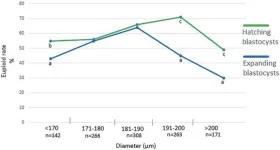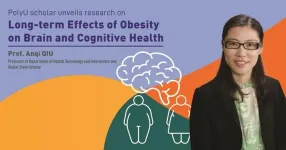(Press-News.org) PULLMAN, Wash. – Preparing catalysts by sending hot, steamy car exhaust over them could improve their efficiency and reduce the amount of rare and expensive metals required in vehicle catalytic converters and many other emission control and industrial processes.
Reporting in the journal, Nature, an international team of researchers found that the hot car exhaust containing nitrogen oxides and carbon monoxide caused a previously unknown reaction that, used proactively, can significantly improve catalytic activity. Catalysts are substances that increase the rate of chemical reactions.
The researchers found that hot exhaust encouraged ceria particles, one of the components of the catalyst materials, to form two-dimensional, nano-sized clusters. These clusters, densely covering the surface, create many sites where chemical reactions can happen, increasing the efficiency of the process. The method also creates a large number of loosely bound oxygen ions associated with cerium atoms, which can move easily and further improve many, common catalytic reactions that require either adding or taking away oxygen.
“They act like an oxygen sponge, and once the oxygen is easily activated, it’s very useful for many reactions requiring oxygen, like oxidation of hydrocarbons and carbon monoxide,” said Yong Wang, one of the study’s corresponding authors and Regents Professor in Washington State University’s Gene and Linda Voiland School of Chemical Engineering and Bioengineering. “This offers better design of a catalyst for multiple reactions.”
Serendipitously discovered, the new treatment method was found to improve catalytic activity by about ten times.
“Luck was a factor in this. Sometimes, we just stumble into a great science discovery. At the same time, this is one which is of practical interest,” said Wang, who also holds a joint appointment with Pacific Northwest National Laboratory.
Researchers are continually trying to improve catalytic converters and other emission control technologies. Over their lifetime, these technologies for removing pollutants from the exhaust streams of cars or power plants become less effective. Manufacturers have to include extra amounts of rare and expensive metals, such as rhodium, platinum, or palladium, in the converter to compensate for the catalyst’s degradation and to meet required emission standards.
One mystery that has befuddled industry for many years is that while nano-sized metal materials in catalytic converters are known to “sinter”, or glob together into larger particles and become ineffective over time when exposed to very hot and harsh conditions of the exhaust steam, the catalytic converters somehow still hold up better than expected.
“If you look at the ceria particle size growth, you would expect at least a hundred times reduction in activity, and that’s not the case,” said Konstantin Khivantsev, a staff scientist and chemical engineer at Pacific Northwest National Laboratory (PNNL) and a corresponding author. “There is a process that was not discovered or recognized, but it contributed to improved dispersion and catalytic activity.”
The researchers, including from WSU, PNNL, University of New Mexico, University of Sofia, Bulgaria, and Purdue University, decided to artificially age a catalyst to study it. However, instead of using just water, which is a typical component of aging tests, they decided to run very hot car exhaust over the catalyst for several hours. They observed that the catalyst’s performance improved rather than degraded.
“So, this is part of the fun of doing research because intuition told us that the catalyst would de-activate, and the results were the complete opposite,” said Abhaya Datye, Distinguished Regents Professor Emeritus at the University of New Mexico and a corresponding author. “We then asked ourselves whether this was real, and repeated the experiment several times. The next step was to figure out the science.”
They discovered that catalytic converters do not degrade as quickly as expected because the hot car exhaust, unbeknownst to the researchers in the field, had actually been aiding the reactions occasionally in short bursts when the car exhaust was at especially high temperatures. In terms of practical impact, the researchers now want to use the treatment process on purpose -- pre-activating the catalyst and purposely forming the reactive state at the beginning of the catalyst’s life.
The new treatment technique could allow for the reduction of the amount of precious metals, such as rhodium, required in the catalyst, offering significant cost savings. Catalytic converters in a car usually contain about $800 worth of rhodium.
“In the spent catalysts, atomically thin patches of ceria that formed during the dispersion of ceria nanoparticles, are in in contact with precious metals, such as rhodium and platinum,” said János Szanyi, a corresponding author and staff scientist at PNNL. “This allows the catalysts to survive harsh temperature conditions of vehicle exhaust and still maintain their activity.”
The researchers have been testing their catalyst treatment at the lab scale. They’re also working with industry partners to test them in vehicles under real operating conditions. The work relied on fundamental science that was supported by the U.S. Department of Energy’s Office of Science, Basic Energy Sciences, Catalysis Science program. The research at PNNL was supported by the U.S. Department of Energy’s Energy Efficiency and Renewable Energy Vehicle Technologies Office.
END
Serendipitous discovery could lead to more efficient catalysts
2025-04-09
ELSE PRESS RELEASES FROM THIS DATE:
Engineering smart delivery for gene editors
2025-04-09
Overcoming Delivery Challenges in Gene Editing
Modern genome editing techniques, including CRISPR systems, hold great potential for treating genetic diseases. However, delivering these molecular tools reliably to their target cells remains a significant challenge.
“Previous viral and non-viral delivery systems such as adeno-associated viruses (AAVs), lipid nanoparticles (LNPs), and other virus-like particles (VLPs), have been valuable but face limitations,” says Dr. Dong-Jiunn Jeffery Truong, last author ...
Six ape genomes sequenced telomere-to-telomere
2025-04-09
Comprehensive reference genomes have now been assembled for six ape species: siamang (a Southeast Asian gibbon), Sumatran orangutan, Bornean orangutan, gorilla, bonobo and chimpanzee. Areas of their genomes previously inaccessible because of structural complexity have now mostly been resolved.
The resource is already lending itself to comparative studies that offer new insights into human and ape evolution, and into what underlies the functional differences among these species.
A report on how the telomere-to-telomere ape genome references were developed, and what scientists are learning from it, appears in the April 9 edition ...
Hubble Space telescope unveils the first images of ongoing star cluster mergers near the center of dwarf galaxies
2025-04-09
A new study reports the first direct observation of merging star clusters in the nuclear region of dwarf galaxies. This detection confirms the feasibility of this formation route for nuclei in dwarf galaxies, which has long been debated. The study was published in Nature science journal, and led by Postdoctoral Researcher Mélina Poulain from the University of Oulu, Finland.
Dwarf galaxies are the most abundant type of galaxies that populate the Universe. Composed of 100 times fewer stars than the ...
‘Sugar’ signatures help identify and classify pancreatic cancer cell subtypes
2025-04-09
GRAND RAPIDS, Mich. (April 9, 2025) — Van Andel Institute scientists and collaborators have developed a new method for identifying and classifying pancreatic cancer cell subtypes based on sugars found on the outside of cancer cells.
These sugars, called glycans, help cells recognize and communicate with each other. They also act as a cellular “signature,” with each subtype of pancreatic cancer cell possessing a different composition of glycans.
The new method, multiplexed glycan immunofluorescence, combines ...
Every cloud has a silver lining: DeepSeek’s light through acute respiratory distress syndrome shadows
2025-04-09
Acute respiratory distress syndrome (ARDS) continues to be a tough nut to crack in critical care, taking lives despite years of research and better ventilator strategies. It is defined by acute hypoxemia, bilateral infiltrates on chest imaging, and non-cardiogenic pulmonary edema, and it remains a heterogeneous condition with mortality rates stubbornly close to 40%. Its complexity—spanning diverse etiologies, inflammatory profiles, and therapeutic responses—demands innovative solutions beyond traditional paradigms. In recent years, artificial intelligence ...
Scientific Program announced for inaugural eLTER Science Conference in Finland
2025-04-09
The scientific programme for the inaugural eLTER Science Conference has just been launched, marking a major milestone in the lead-up to the event. Held from 23 to 27 June 2025 in Tampere, Finland, the conference will explore integrated, policy-relevant approaches to ecosystem and socio-ecological research under the theme: “Toward a whole-system approach to ecosystem science.”
Organised by the Integrated European Long-Term Ecosystem, critical zone and socio-ecological systems Research Infrastructure (eLTER RI), the event is expected to welcome over 300 participants from across Europe and beyond.
The scientific programme features:
25 keynote speakers recognised for their leadership ...
Does blastocyst size matter? Exploring reproductive aging and genetic testing
2025-04-09
“[…] when selecting non-PGT-A tested embryos for embryo transfer (ET) or frozen embryo transfer (FET), a small hatching blastocyst seems to be a better choice than a large expanded one, especially for advanced-age patients for whom the risk of aneuploidy is higher.”
BUFFALO, NY — April 9, 2025 — A new research paper was published in Aging (Aging-US) Volume 17, Issue 3, on March 5, 2025, titled “Reproductive aging, preimplantation genetic testing for aneuploidy, and the diameter of blastocysts: does size matter?”
In this study, a team led by first author Jakub Wyroba from the Malopolski Institute of Fertility Diagnostics ...
2025 EurekAlert! Travel Awards for International Science Reporters applications now open
2025-04-09
Applications for the 2025 EurekAlert! Travel Awards for International Science Reporters are now open to early-career science journalists from Brazil and countries in Eastern Europe. Two winners will be selected to receive travel funding from EurekAlert! to attend the 2026 AAAS Annual Meeting, taking place February 12-14, 2026 in Phoenix, Arizona, USA. Learn more about who is eligible and how to apply on our website. The application deadline is May 5 at 11:59 p.m. U.S. Eastern Time.
Learn More and Apply!
The American Association for the Advancement of Science (AAAS) is the world’s largest multidisciplinary scientific society, and the AAAS Annual Meeting brings together ...
Menstrual cycle may contribute to sickle cell disease pain crises
2025-04-09
(WASHINGTON— April 9, 2025) — A marker linked to inflammation, C-reactive protein, may increase significantly during the follicular phase of the menstrual cycle in female patients with sickle cell disease (SCD), according to emerging research published today in Blood Vessels, Thrombosis & Hemostasis. This observation provides insight into the pattern of painful vaso-occlusive events (VOEs), which are driven by inflammation, in female patients with the disorder.
“We know both from the literature and anecdotally from our patients that women with SCD have VOEs that cluster ...
PolyU scholar unveils research on long-term effects of obesity on brain and cognitive health
2025-04-09
With the global prevalence of obesity on the rise, it is crucial to explore the neural mechanisms linked to obesity and its influence on brain and cognitive health. However, the impact of obesity on the brain is complex and multilevel. To address this, Prof. Anqi QIU, Professor of the Department of Health Technology and Informatics at the Hong Kong Polytechnic University (PolyU) and Global STEM Scholar, has unveiled novel research to advance our understanding of the neural mechanisms underlying the relationship between obesity and its implications for cognitive health in adults.
Obesity ...




